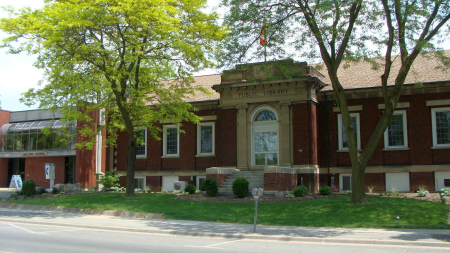
The staff at Welland Historical Museum will soon be cheering when all the paint and tools are put away. Renovating the 91 year-old heritage at 140 King Street building presented some unexpected challenges and safety hazards, but the work is nearly done and you can preview the beautifully refurbished, bright Carnegie Gallery here. Grand re-opening celebrations are slated for sometime in 2015.
ArtsBuild contacted Welland Historical Museum staff to get a behind-the-scenes perspective on their renovations, and to share insights on the process of planning and executing a multi-phase capital improvement project. Read on to learn how Welland Museum planned and funded their project, who was involved, what types of contractors they needed, how they adjusted their plans when needed, and what advice they’d offer to other cultural organizations considering a capital project.
Jump to a topic:
– What changes were made
– Goals and benefits of the renovation
– How the building’s age affected the process
– Planning team, consultants, planning process
– Execution and obstacles
– Funding
– Advice for other organizations considering capital projects
What changes were made
Q: How extensive is this renovation? Tell us about some of the changes encompassed.
A: Quite extensive. It has included the following: removal of asbestos floor tiles in the archives which meant emptying the entire second floor of the building; new flooring in the main gallery space (that room also emptied); lighting retrofit with new track lights in gallery spaces on all three levels; freight elevator retrofit (to begin soon); new museum quality shelving in the second level archives. Unexpectedly we also had to rip out carpet in the lower level gallery due to flooding which meant the floor had to be scraped and painted. Other unplanned items included a collapsing floor in the furnace room hallway due to blocked hot water outlet from the steam boiler and other maintenance issues such as leaking eavestroughs damaging walls, roof repair, repainting, weatherstripping, etc.
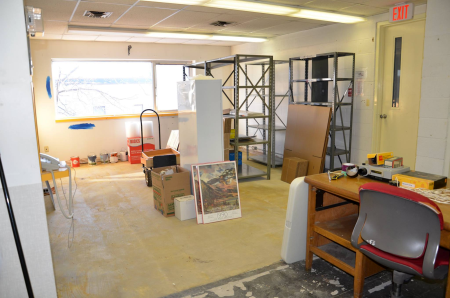
Goals and benefits of the renovation
Q: What museum activities and goals will become possible thanks to this renovation?
A: Proper lighting of gallery spaces will enhance the overall look of the exhibits, protect the artefacts and combined with the new lighting in the office and storage spaces will save on hydro bills. Museum quality shelving will allow us to increase the capacity of our storage and assist with a better organizational system. The elevator retrofit will bring the current one up to code and allow persons to ride on the elevator instead of solely objects. Other repairs address long-standing maintenance issues.
Q: How will this renovation benefit your audience and the community more broadly?
A: Better lighting will enhance the exhibits making them more attractive to visitors. It means a more enjoyable visit to the museum with less glare and strain on the eyes of the public. The elevator repair will meet accessibility standards and allow volunteers and researchers to access the second level archives via the elevator if needed instead of walking a number of flights of stairs.
How the building’s age affected the process
Q: How has the building’s age and heritage designation influenced matters?
A: In this case the building’s heritage designation has provided little impediment to the project as the only renovations occurring in the heritage designated part of the building were minor (lighting retrofit and flooring). The age of the building and some original construction practices from the 1970’s have become major hurdles to the installation of the new shelving units requiring additional assessment and additional expense.
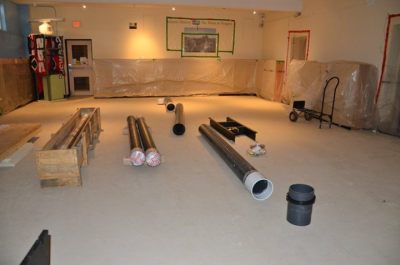
Planning team, consultants, planning process
Q: Who is on your planning team?
A: Museum Executive Director, Museum Curator, Museum Archivist, City of Welland staff, Welland Hydro and a Lighting System Consultant.
Q: What kind of consultants and contractors did you need for this project?
A: Lighting system consultant; electricians, environmental consultants and removal company (asbestos), elevator installation and repair company, structural engineers, general contractors, painters, flooring company, roofers.
Q: Give us an overview of your planning process. What were the main steps, goals, surprises and learning moments for you and your team?
A: As several of these initiatives were brought to us by outside agencies (Hydro, City) or forced on us by circumstances (elevator not being re-certified) the planning process grew organically. The three main projects – lighting, shelving and elevator – were originally the only projects planned but as the planning progressed other issues were added (i.e. need for asbestos remediation). This was all supposed to be completed between January and April of this year. The biggest surprises were the many unexpected issues that cropped up (i.e. asbestos, flooring issues with regard to the storage units) and the delays.
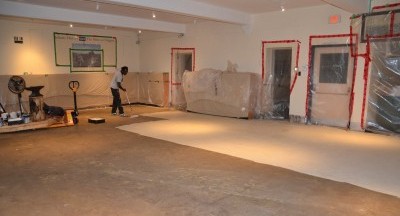
Execution and obstacles
Q: How’s the construction process going? Have you needed to make any adaptations to your plans during construction?
A: The lighting project had to be scaled back somewhat in order to meet the budget. The dust from the flooring project and tape on walls to hold the plastic sheeting necessitated unexpected repainting in some areas.
Q: Are things proceeding on time, as estimated?
A: Despite reassurances to the contrary, there have been many delays due to the product being unavailable, strikes, paperwork not completed, etc. The longest delay has been with the start of the elevator project – six months after the original start date. This has had a ripple effect on all aspects of our operations and on our planned re-opening date.
Funding
Q: How is this project funded?
A: The lighting project was funded by the City of Welland with incentives from Welland Hydro. The elevator is funded by the City of Welland with a $50,000.00 grant from the Federal Government Enabling Accessibility Fund. The shelving project is funded by the Ontario Trillium Foundation and Department of Canadian Heritage Museums Assistance Program. Other maintenance and repairs were funded by the City of Welland. Some painting will be funded by the Museum.
Q: Was this project part of any other initiative, for example, a municipal culture plan, economic development initiative, or brownfield redevelopment?
A: The lighting project was part of an energy saving project by the City of Welland for all municipal facilities that was initiated by Welland Hydro who also provided monetary incentives.
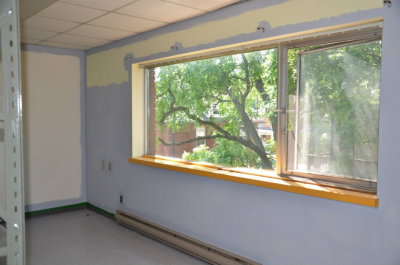
Advice for other organizations considering capital projects
Q: What advice would you give to other facility managers when considering capital projects?
A: Always leave more time for the renovations than estimated by the consultant and contractors. If the estimate is x amount of time, double that estimate at the very least or triple it. Know as much as you can about your building before initiating any renovation project. A structural engineering assessment in advance is always a good idea. Be prepared to supervise contractors and answer questions and act as a liaison with those supervising for the municipality as you will be the person on site all the time. No matter who is funding the project, allow a “cushion” in your own budget for unexpected expenses.
—
Do you have a recent or ongoing capital project that you’d like to share? Contact Natalee.
For help with planning maintenance, renovation and building, see our step-by-step guide, PLAN IT | BUILD IT, and ArtsBuild’s Resource Library of case studies, templates, reports, videos, and podcasts about sustaining creative spaces.

